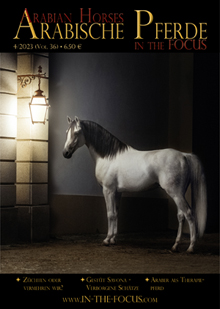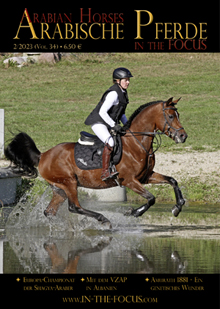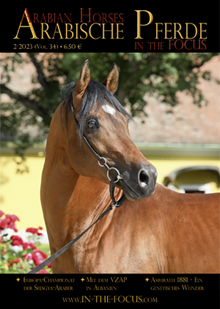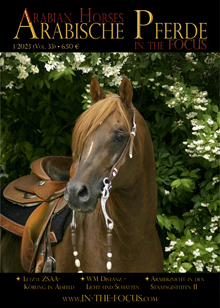With Dani El Barbary one of the most passionate horse women of Egypt has died. Emancipated and self-assured, she followed her heart and devoted herself entirely to her horse breeding – not a given thing for a woman in Egypt.

Dani El Barbary with her own stallion Waley El Ahd (Beltagi / Set El Hosn II) * 1999 during my visit to Shams Al Asil 2003.
As a young woman she became, and learned in several stables in Europe. Horses became her great passion and she was the only female team member of the show jumping team of Egypt in her active riding time. But it was especially the intelligence and inner qualities of the Arabian horse that had done it to her, and sooner or later she found her way into breeding. She received valuable advice and help from the then stud manager of El Zahraa, Tibor von Pettkö-Szandtner, but looked also at the other stud farm of the time, Inshass and Hamdan Stables, and in the early 1970s bought a group of young mares who became the foundation of her stud “Shams Al Asil”.
Her first stallion was Bilal I (Morafic / Mona) * 1969 from El Zahraa. It cost her two years of persuasion, until Dr. Marsafy let this Morafic son go. But he quickly became her great love and the founding stallion of her stud. He was more akin to the Saklawi type, slender and elegant. A counterpart to this was the later added Misk (Wahag / Nazeema) * 1979, which was strong and compact. The combination of these two stallions was later to characterize the breeding program.
According to Tibor of Pettkö-Szandtner’s motto: “No legs, no horse”, she attached great importance to good, correct legs. The mares and their qualities were the most important thing in her breeding selection. She defined the type differently than the modern show ring, whose fashion with regards to type she criticised sometimes hard.
In more than 40 years as a breeder and around 8 to 9 generations of horses born at Shams Al Asil, she was always guided by her love and passion for the Arabian horse. In an interview, she once said, “If you want a courageous friend to ride and enjoy, then you should have an Arabian. You need to feel that friendship, because this is who the Arabian was meant for.”
Gudrun Waiditschka
Following an extract of an article which I wrote, after I visited Dani El Barbary in 2003 (Araber Journal 4/2004):
Shams El AssilOne of the most passionate horsewomen of Egypt is Wegdan El Barbary of Shams El Assil. Today in her 80ies, she has been a competition rider in her younger days and a devoted breeder of Arabians for decades. This is testified by the 6th or even 7th generation of Shams El Assil-breeding on the dam’s side, e.g. horses tracing back to the Dahman mare Fanar (Nasralla/Bint Bukra) *1965, purchased from the EAO. A worthy representative of this line is SEA Solaymah (out of SEA El Hedia) *1990, the last foal of Bilal I. |












